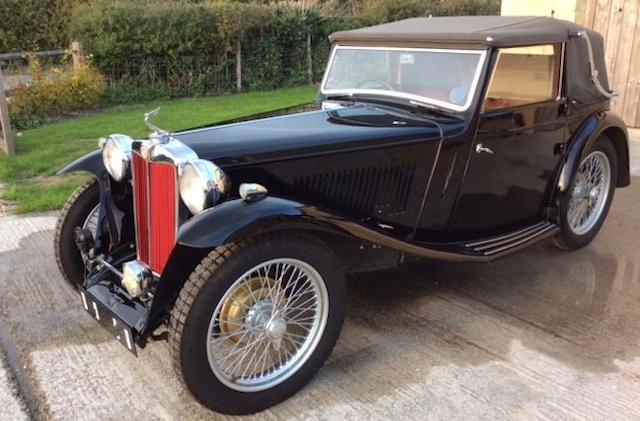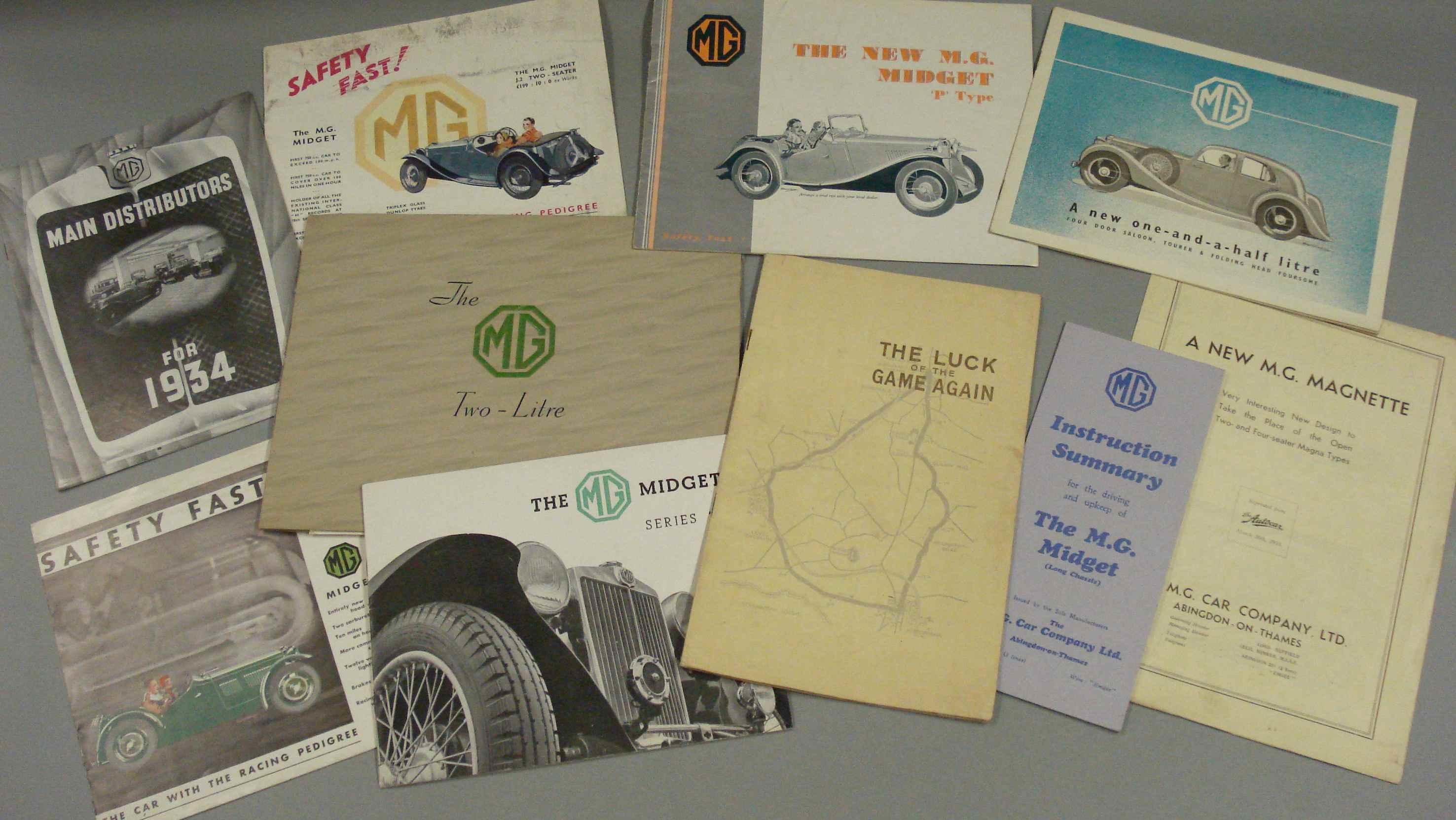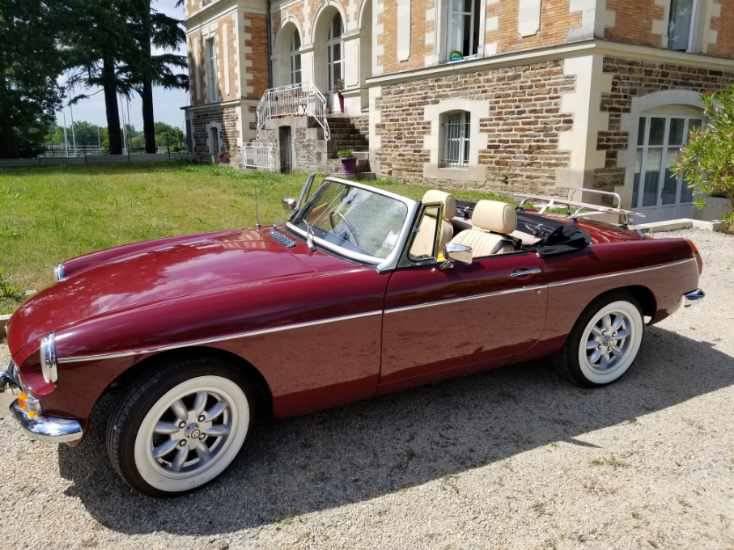14 1934 MG Q-Type Registration No. JB 4231 (see text) Chassis No. QA 0252 Engine No. 2228 AP Red with black interior. Engine: 4 cylinder, 746cc, supercharged; Gearbox: pre-selector four speed with overload clutch; Brakes: four wheel 12" drum, cable operated; Suspension: semi-elliptic leaf springs with sliding trunnions. Right hand drive. Little could rival the MG Midget in the early 1930s, the combination of value for money, cheap running costs and useful performance capturing the imagination of many sports car enthusiasts of the period. With a supercharger fitted, the MG PB had few equals in its day, and a factory-supported team known as the "Cream Crackers" were particularly successful in trials. Although the PA and PB Midgets were both sports cars they were not racing cars, so in 1934 a new model, the Q-Type, was offered to the racing enthusiast. Just eight cars were produced by the Abingdon factory between May and September and they are regarded as the ultimate traditional overhead cam-engined MG Midget. It featured a 746cc supercharged P-type engine, capable of producing well in excess of 100bhp; indeed, in its final racing form in 1936 it produced nearly 147bhp at 7,500rpm. This figure was higher than any other racing engine in the world at that time and equated to over 200bhp per 1,000cc! To add stability at the inevitable high speeds, it was decided to increase the wheelbase and track on the basis that the extra power would more than compensate for the additional weight. The wheelbase was made the same as on the K3, and N-type axles of 3' 9" track, with special 12" brake drums, were used. A pre-selector four speed gearbox was developed with an elegant safety device in the form of a clutch built in to the fly wheel, in order to preserve the life of the rear axle. Consequently, when changing gear and taking full advantage of the high speed pre-selector gearchange, the fly wheel clutch slipped momentarily and avoided any potential damage to the rear axle. In general layout the car followed the 1934 MG K3 very closely and in side elevation it is not easy to tell the two models apart. All eight Q-types were originally fitted with very attractive open two-seat sports racing coachwork with a sloping, pointed tail and outside exhaust. Being a road racing car their cockpit was purely functional with large, easy to read instruments and no doors. Other features were twin fuel fillers and an emergency oil tank under the scuttle to re-fill the sump whilst racing, thus avoiding extra pit stops. The final track testing of the Q-type was undertaken by Bill Everitt and on Whit Monday, 1934, he broke the Class H Brooklands Mountain lap record at 69.97mph, first time out. He then competed at a Donington Park race meeting, achieving a first place and two seconds. At Brooklands on August 1st he broke the Standing Kilometer and Standing Mile records at 69.75 and 79.88mph respectively - this was a direct measure of the improvement of the Q-type since these records were taken from E.R. Hall who had set them the previous year in an MG J4. In October 1934, Everitt raised the Mountain Lap record to 75.58mph in the Q-Type and the Standing Kilometer and Mile records to the remarkable figures of 75.42 and 85.59mph. It is interesting to note that the Mountain speed was almost 3mph faster than the 1,100cc record held by Seaman in an MG K3 and that the Standing Mile beat Horton's 1,100cc record in the Special MG K3, established two months earlier. The rare Q-Type on offer today is the second car built by the factory. It was completed on 31st May 1934 and by April 1935 was reported to be in the ownership of Bellevue Garage. It passed through the hands of Rowland Smith Motors in April 1938 and by the end of the 1930s was purchased by a Mr. Hugh Howarth of Adlington, Lancashire, who subsequently sold it to his great friend Ted Lund, a lifelong MG enthusiast. Mr. Lund proceeded to use the car on the road, registered JB 4231, as often as the wartime
14 1934 MG Q-Type Registration No. JB 4231 (see text) Chassis No. QA 0252 Engine No. 2228 AP Red with black interior. Engine: 4 cylinder, 746cc, supercharged; Gearbox: pre-selector four speed with overload clutch; Brakes: four wheel 12" drum, cable operated; Suspension: semi-elliptic leaf springs with sliding trunnions. Right hand drive. Little could rival the MG Midget in the early 1930s, the combination of value for money, cheap running costs and useful performance capturing the imagination of many sports car enthusiasts of the period. With a supercharger fitted, the MG PB had few equals in its day, and a factory-supported team known as the "Cream Crackers" were particularly successful in trials. Although the PA and PB Midgets were both sports cars they were not racing cars, so in 1934 a new model, the Q-Type, was offered to the racing enthusiast. Just eight cars were produced by the Abingdon factory between May and September and they are regarded as the ultimate traditional overhead cam-engined MG Midget. It featured a 746cc supercharged P-type engine, capable of producing well in excess of 100bhp; indeed, in its final racing form in 1936 it produced nearly 147bhp at 7,500rpm. This figure was higher than any other racing engine in the world at that time and equated to over 200bhp per 1,000cc! To add stability at the inevitable high speeds, it was decided to increase the wheelbase and track on the basis that the extra power would more than compensate for the additional weight. The wheelbase was made the same as on the K3, and N-type axles of 3' 9" track, with special 12" brake drums, were used. A pre-selector four speed gearbox was developed with an elegant safety device in the form of a clutch built in to the fly wheel, in order to preserve the life of the rear axle. Consequently, when changing gear and taking full advantage of the high speed pre-selector gearchange, the fly wheel clutch slipped momentarily and avoided any potential damage to the rear axle. In general layout the car followed the 1934 MG K3 very closely and in side elevation it is not easy to tell the two models apart. All eight Q-types were originally fitted with very attractive open two-seat sports racing coachwork with a sloping, pointed tail and outside exhaust. Being a road racing car their cockpit was purely functional with large, easy to read instruments and no doors. Other features were twin fuel fillers and an emergency oil tank under the scuttle to re-fill the sump whilst racing, thus avoiding extra pit stops. The final track testing of the Q-type was undertaken by Bill Everitt and on Whit Monday, 1934, he broke the Class H Brooklands Mountain lap record at 69.97mph, first time out. He then competed at a Donington Park race meeting, achieving a first place and two seconds. At Brooklands on August 1st he broke the Standing Kilometer and Standing Mile records at 69.75 and 79.88mph respectively - this was a direct measure of the improvement of the Q-type since these records were taken from E.R. Hall who had set them the previous year in an MG J4. In October 1934, Everitt raised the Mountain Lap record to 75.58mph in the Q-Type and the Standing Kilometer and Mile records to the remarkable figures of 75.42 and 85.59mph. It is interesting to note that the Mountain speed was almost 3mph faster than the 1,100cc record held by Seaman in an MG K3 and that the Standing Mile beat Horton's 1,100cc record in the Special MG K3, established two months earlier. The rare Q-Type on offer today is the second car built by the factory. It was completed on 31st May 1934 and by April 1935 was reported to be in the ownership of Bellevue Garage. It passed through the hands of Rowland Smith Motors in April 1938 and by the end of the 1930s was purchased by a Mr. Hugh Howarth of Adlington, Lancashire, who subsequently sold it to his great friend Ted Lund, a lifelong MG enthusiast. Mr. Lund proceeded to use the car on the road, registered JB 4231, as often as the wartime















Try LotSearch and its premium features for 7 days - without any costs!
Be notified automatically about new items in upcoming auctions.
Create an alert